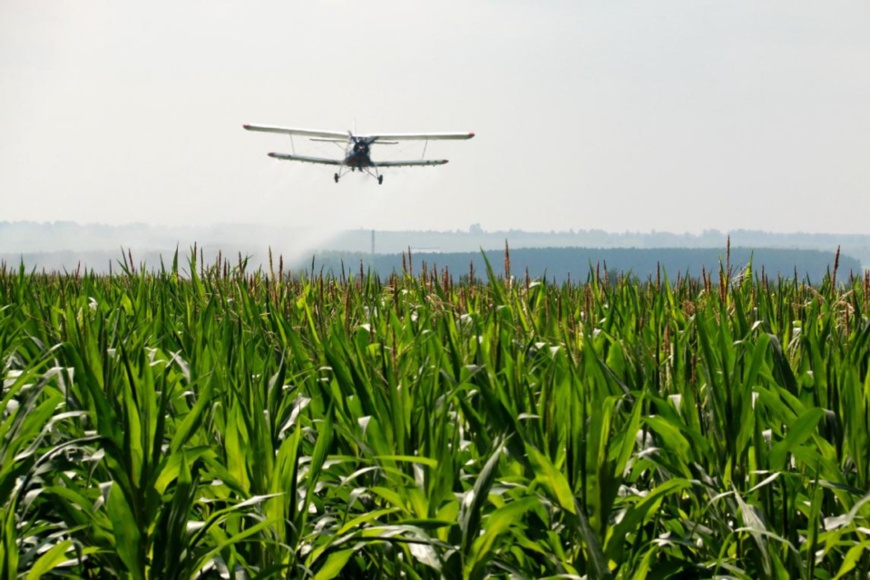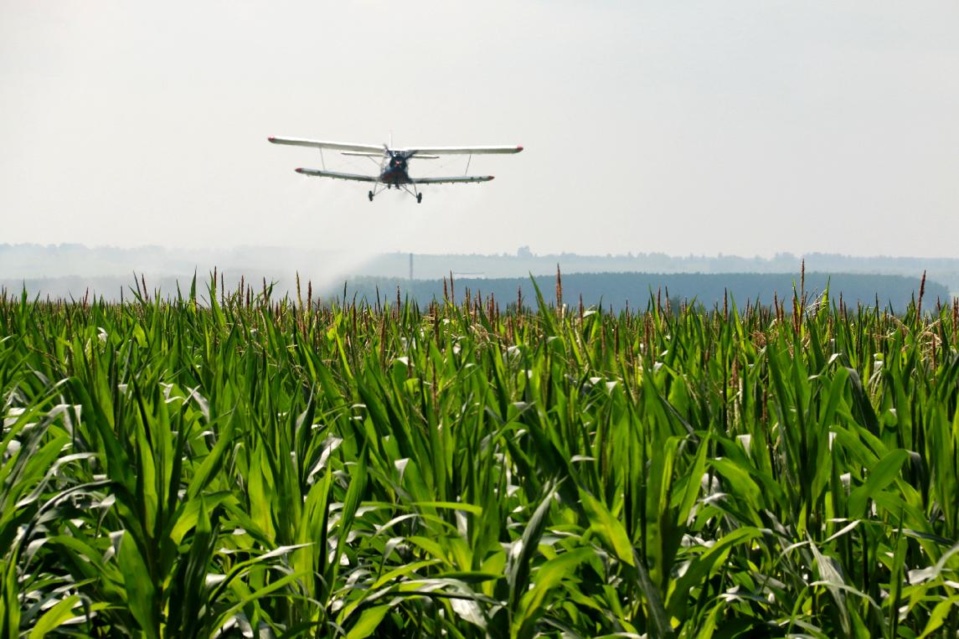By Hao Yingcan, Zhang Yikai, People’s Daily

A drone sprays nutrient solution over a corn field at Wudalianchi farm, Heihe city, northeast China’s Heilongjiang province, July 21, 2021. (Photo by Lu Wenxiang/People’s Daily Online)
This year, northeast China’s Heilongjiang province witnessed a total grain output of nearly 78.68 billion kilograms, an increase of about 3.27 billion kilograms from the previous year, accounting for 11.5 percent of the country’s total grain output.
The province has recorded good grain harvest for 18 consecutive years, and its annual grain output has ranked first in China for 11 years in a row. Such an achievement couldn’t have been possible without the province’s efforts to develop smart agriculture.
As one of China’s main grain producing areas, Heilongjiang has vigorously implemented the strategy of sustainable farmland use and innovative application of agricultural technology to increase farmland productivity.
The province’s comprehensive agricultural mechanization rate, coverage rate of improved varieties of major crops, and contribution rate of scientific and technological progress to agriculture have reached 98 percent, 100 percent, and 68.3 percent, respectively. Multiple agricultural indicators of the province rank first in the country.
Thanks to the efforts of the province to carry out projects to promote the construction of high-standard farmland and protect black soil, gullies in farmland have been effectively smoothed out, the once small pieces of land have been turned into large contiguous farmland, and ditches, bridges and culverts have been built to form smooth water passages, making it more convenient for the use of large machinery.
Han Xiaoyu, a villager in Keshan county, Heilongjian province, has 10 hectares of flat and contiguous farmland, which was dotted with gullies three years ago.
In the past, only half of the land could be used for cultivation, and every year nearly five millimeter thick of the black soil was washed away, Han recalled.
“Past gullies have been transformed into high-standard farmland, and our yield has also doubled this year,” Han said happily.
According to local landforms and climatic conditions, the province has classified the black soil cultivated land into four categories, and then tailored measures for comprehensive management and protection, according to Wang Zhaoxian, head of the Department of Agriculture and Rural Affairs of Heilongjiang Province.
Agricultural technology plays a key role in the realization of good harvests in Heilongjiang. At the farm machinery storage facility of Hu Chunguang, a farmer at Daxing farm operated by Beidahuang Group, a large agricultural and agribusiness group in China, rows of modern agricultural mechanical devices are particularly eye-catching.
With the help of the government, Hu had automated terminals using BeiDou Navigation Satellite System installed on his agricultural machinery and sowed seeds of high-quality new crop varieties recommended by local agricultural technology department this year.
“I have not only saved 5,000 yuan ($785) to 6,000 yuan of labor costs, but realized precision farming from sowing to harvesting through machinery,” Hu said, adding that the yield per mu (one mu equals 0.067 hectares) of land has reached about 600 kilograms this year, nearly 50 kilograms more than that in 2020.
Since 2016, by integrating its scientific and technological resources, Heilongjiang has established technological collaborative innovation systems concerning 17 industries, including soybeans, rice, corn, and grains, Wang pointed out.
Focusing on the construction of a 1,000-kilometer high-standard technology demonstration belt, Heilongjiang has built four national modern agricultural technology demonstration bases, 58 high-standard modern agricultural technology parks, and 150 modern agricultural technology demonstration bases, cultivated more than 3,000 modern agricultural technology demonstration entities, and made sure that the availability rate of main agricultural technologies in the province stabilizes at more than 95 percent.
Besides, the province has actively promoted new agribusiness models to make agricultural production more professional and easier for farmers.
Zhao Jian, a farmer in Songhuajiang township, Bayan county, Heilongjiang, has been working in cities for many years and couldn’t take care of his farmland back home. Last year, he began to trust a local professional farming cooperative with the management of his 40 mu of land.
“After the professional farming cooperative took over my land, I can even earn 600 to 700 yuan more from each mu of land a year,” Zhao said.
Agricultural service agencies like the professional farming cooperative provide one-stop or tailored services for farmers, from seed purchasing, cultivating to harvesting and selling, said Chen Weidong, deputy director at the agriculture and rural affairs bureau of Bayan county, adding that they have saved costs, increased efficiency, and improved quality and quantity of agricultural production by integrating resources.
Entrusting whole-process farming to professional agencies has promoted appropriately scaled operation of farmland, which not only improves machinery utilization efficiency, stimulates the promotion and application of new technologies, effectively increases the income of agricultural production and operation entities such as farmers, service agencies, agricultural brokers, and agricultural equipment operators, and ensures risk sharing in agricultural production and operation, according to Li Jiawen, an official with the Department of Agriculture and Rural Affairs of Heilongjiang Province.
“We must accelerate the construction of a modern agricultural management system and make great strides in promoting agricultural modernization,” Wang said.
The province has recorded good grain harvest for 18 consecutive years, and its annual grain output has ranked first in China for 11 years in a row. Such an achievement couldn’t have been possible without the province’s efforts to develop smart agriculture.
As one of China’s main grain producing areas, Heilongjiang has vigorously implemented the strategy of sustainable farmland use and innovative application of agricultural technology to increase farmland productivity.
The province’s comprehensive agricultural mechanization rate, coverage rate of improved varieties of major crops, and contribution rate of scientific and technological progress to agriculture have reached 98 percent, 100 percent, and 68.3 percent, respectively. Multiple agricultural indicators of the province rank first in the country.
Thanks to the efforts of the province to carry out projects to promote the construction of high-standard farmland and protect black soil, gullies in farmland have been effectively smoothed out, the once small pieces of land have been turned into large contiguous farmland, and ditches, bridges and culverts have been built to form smooth water passages, making it more convenient for the use of large machinery.
Han Xiaoyu, a villager in Keshan county, Heilongjian province, has 10 hectares of flat and contiguous farmland, which was dotted with gullies three years ago.
In the past, only half of the land could be used for cultivation, and every year nearly five millimeter thick of the black soil was washed away, Han recalled.
“Past gullies have been transformed into high-standard farmland, and our yield has also doubled this year,” Han said happily.
According to local landforms and climatic conditions, the province has classified the black soil cultivated land into four categories, and then tailored measures for comprehensive management and protection, according to Wang Zhaoxian, head of the Department of Agriculture and Rural Affairs of Heilongjiang Province.
Agricultural technology plays a key role in the realization of good harvests in Heilongjiang. At the farm machinery storage facility of Hu Chunguang, a farmer at Daxing farm operated by Beidahuang Group, a large agricultural and agribusiness group in China, rows of modern agricultural mechanical devices are particularly eye-catching.
With the help of the government, Hu had automated terminals using BeiDou Navigation Satellite System installed on his agricultural machinery and sowed seeds of high-quality new crop varieties recommended by local agricultural technology department this year.
“I have not only saved 5,000 yuan ($785) to 6,000 yuan of labor costs, but realized precision farming from sowing to harvesting through machinery,” Hu said, adding that the yield per mu (one mu equals 0.067 hectares) of land has reached about 600 kilograms this year, nearly 50 kilograms more than that in 2020.
Since 2016, by integrating its scientific and technological resources, Heilongjiang has established technological collaborative innovation systems concerning 17 industries, including soybeans, rice, corn, and grains, Wang pointed out.
Focusing on the construction of a 1,000-kilometer high-standard technology demonstration belt, Heilongjiang has built four national modern agricultural technology demonstration bases, 58 high-standard modern agricultural technology parks, and 150 modern agricultural technology demonstration bases, cultivated more than 3,000 modern agricultural technology demonstration entities, and made sure that the availability rate of main agricultural technologies in the province stabilizes at more than 95 percent.
Besides, the province has actively promoted new agribusiness models to make agricultural production more professional and easier for farmers.
Zhao Jian, a farmer in Songhuajiang township, Bayan county, Heilongjiang, has been working in cities for many years and couldn’t take care of his farmland back home. Last year, he began to trust a local professional farming cooperative with the management of his 40 mu of land.
“After the professional farming cooperative took over my land, I can even earn 600 to 700 yuan more from each mu of land a year,” Zhao said.
Agricultural service agencies like the professional farming cooperative provide one-stop or tailored services for farmers, from seed purchasing, cultivating to harvesting and selling, said Chen Weidong, deputy director at the agriculture and rural affairs bureau of Bayan county, adding that they have saved costs, increased efficiency, and improved quality and quantity of agricultural production by integrating resources.
Entrusting whole-process farming to professional agencies has promoted appropriately scaled operation of farmland, which not only improves machinery utilization efficiency, stimulates the promotion and application of new technologies, effectively increases the income of agricultural production and operation entities such as farmers, service agencies, agricultural brokers, and agricultural equipment operators, and ensures risk sharing in agricultural production and operation, according to Li Jiawen, an official with the Department of Agriculture and Rural Affairs of Heilongjiang Province.
“We must accelerate the construction of a modern agricultural management system and make great strides in promoting agricultural modernization,” Wang said.
 Menu
Menu
 Heilongjiang vigorously develops smart agriculture
Heilongjiang vigorously develops smart agriculture
















